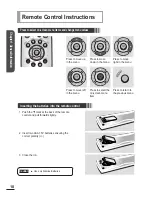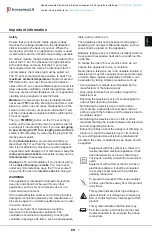
v
● Unplug the LCD TV from the wall outlet and disconnect the antenna or cable system during a
lightning storm or when left unattended and unused for long periods of time. This will prevent
damage to the unit due to lightning and power-line surges.
● Avoid overhead power lines. An outside antenna system should not be placed in the vicinity of
overhead power lines or other electric light or power circuits or where it can fall into such power
lines or circuits. When installing an outside antenna system, be extremely careful to keep from
touching the power lines or circuits. Contact with such lines can be fatal.
● Do not overload the wall outlet or extension cords. Overloading can result in fire or electric
shock.
● Do not insert anything through the openings in the unit, where they can touch dangerous voltage
points or damage parts. Never spill liquid of any kind on the LCD TV.
● Ground outdoor antennas. If an outside antenna or cable system is connected to the LCD TV, be
sure the antenna or cable system is grounded so as to provide some protection against voltage
surges and built-up static charges. Section 810 of the National Electrical Code, ANSI/NFPA
No.70-1984, provides information about proper grounding of the mast and supporting structure,
grounding of the lead-in wire to an antenna discharge unit, size of grounding conductors,
location of antenna discharge unit, connection to grounding electrodes, and requirements for the
grounding electrode.
● Do not attempt to service the LCD TV yourself. Refer all servicing to qualified service personnel.
Unplug the unit from the wall outlet and refer servicing to qualified service personnel under the
following conditions:
- when the power-supply cord or plug is damaged
- if liquid has been spilled on the unit or if objects have fallen into the unit
- if the LCD TV has been exposed to rain or water
- if the LCD TV does not operate normally by following the operating instructions
- if the LCD TV has been dropped or the cabinet has been damaged
- when the LCD TV exhibits a distinct change in performance
● If you make adjustments yourself, adjust only those controls that are covered by the operating
instructions. Adjusting other controls may result in damage and will often require extensive work
by a qualified technician to restore the LCD TV to normal.
● When replacement parts are required, be sure the service technician uses replacement parts
specified by the manufacturer or those that have the same characteristics as the original part.
Unauthorized substitutions may result in additional damage to the unit.
● Upon completion of any service or repairs to this LCD TV, ask the service technician to perform
safety checks to determine that the LCD TV is in a safe operating condition.
● The LCD TV can properly operate in a temperature range of 32~104°F(0~40°C) and 80%
humidity.
Do not use in a hot and humid place.
● Before moving the LCD TV equipped with speakers, separate the speakers from the LCD TV.
If you move the LCD TV with the speakers attached, it may result in damage or injury.
● If main plug is used as the disconnect device, the plug shall remain readily operable.
Summary of Contents for CL260WS
Page 43: ......
Page 53: ......
Page 63: ......
Page 85: ......
Page 93: ......
Page 94: ...Self Service Check List 88 Chapter 9 Appendix Troubleshooting ...
Page 99: ......
Page 100: ...Chapter 10 Additional Information Specifications 94 END USER LIMITED WARRANTY 95 ...
Page 103: ...Memo ...
Page 104: ...Memo ...
Page 105: ...Owner s Instructions ...






































